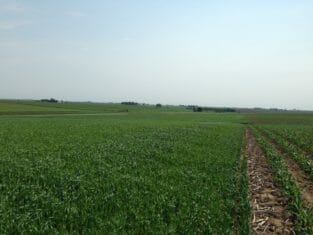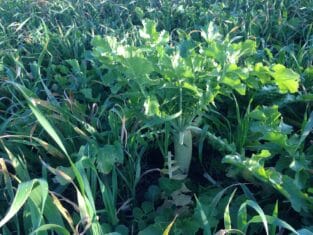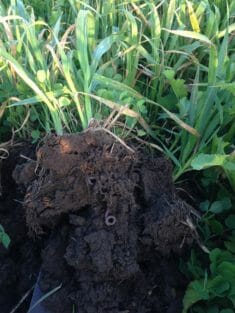Guest Blog: The Essential Conversation Between Landowners and Farmers Over Sustainable Farming
Guest blog from PFI member Clark Porter of Porter Family Farms in Black Hawk County
If farmers own and operate a tractor, then I am not a farmer. However, I grew up riding my pony behind my grandfather on our land, and spent summers throughout high school and college working for various farmers. My family has owned our farm since 1873. My great, great grandfather farmed it – and I want my great, great grandchildren to be as rooted as I am in this soil. That means I have to take care of that soil. For me, it is a living entity – something I have grown in just like the crops.
Like many landowners, I am not an experienced farmer. In spite of this, I am ultimately responsible for being a steward of the land. I am in the awkward position of expressing my preferences but lacking all the information I need to have those preferences met. I have to collaborate with the people who farm our land.
I’m lucky to have trust and a good working relationship with the people farming our ground. I am also more intimately involved in management because we hire custom work as opposed to renting out the land (only 3% of Iowa acres are custom farmed). However, I can imagine how it may be for many, and I believe we have some communication challenges standing between us and desired progress in conservation efforts.

A field of oats growing at Porter Family Farms. Adding a 3rd crop such as oats can provide many benefits for the soil (and the pocketbook, due to low input costs), but brings with it management complexities that need to be discussed between the landowner and farmer.
If both the landowner and the tenant farmer agree on soil conservation, clean water, soil health, tillage practices or other goals for sustainable agriculture, then things should go smoothly. However, I’m not sure things are always so effortless. First, landowners may not be aware of sustainable farming practices. Many may not even be well acquainted with their own land (21% of Iowa landowners live out of state).
Second, some landowners may simply want to maximize their profits and will not be interested in practices that may take some land out of production, like installing waterways. Also, many may not want to be bothered by management decisions and will delegate everything to the tenant.
Tenant farmers have their own set of issues and incentives. Most operate on thin margins at best. They compete with others to hold and rent ground. They are not in a good position to suggest practices that benefit the soil and water, like installing buffer strips along streams or planting cover crops. Installing the buffer strip would cost the landowner money and mentioning it may motivate a landowner to find another tenant. Cover crops will cost the tenant money and time when he or she may already be locked into a high rent and a large number of acres.

The short growing season for oats allows Clark to plant a diverse cover crop mix, including clover, daikon radishes and more oats.
Other tenant farmers may not be aware of practices that save our soil, or they may not have the sort of equipment that allows for it. Others may remove corn stover for animal bedding or ethanol production. There would be little incentive for any of these individuals to bring up the topic of restoring organic matter to the soil, or no-till farming.
The dynamics of land rental, of leases and an array of incentives, can reach an equilibrium over the years. The majority of landowners stick with the same renters for multiple years. Lease agreements recognize the land as a commodity and allocate costs and risks between the parties. Leases come to rest on a foundation of comfortable, and often unspoken, roles and responsibilities. Most conversation is around price and not practices. When you decide to implement practices that are good for the soil or water, you can upset this equilibrium. People then need to hit the “reset” button and talk about risks, responsibilities, costs, and rewards. It’s easy to avoid this conversation and let everything continue as it has. However, this will not change anything.
I have been on a journey as a landowner. I quickly learned about the value of cover crops and tillage practices. However, it took me an embarrassingly long time to discover the additional relationship between tillage practices and planters. Planters are a huge investment, and I discovered that some of my goals were pushing the limits of equipment owned by the people who farm our land. We continue to work together, balancing our mutual objectives.

As a result of planting oats followed by a cover crop, Clark saw healthy changes in soil structure almost immediately.
There are resources for landowners who want to begin the conversation with the people who farm their land. Practical Farmers of Iowa has been enormously helpful to me, so has the Natural Resources Conservation Service. Drake Law School published an extremely informative guide on farm lease agreements that support sustainable practices, and I would urge people to consult this publication.
This state has only been under the plow for about 160 years, and already we have lost mountains of soil that took eons to form into the breadbasket that feeds all of us. My parting advice to landowners would be that if you are interested in passing a beautiful, healthy farm to future generations, if you care about your impact on the future, if you want to see healthy watersheds, then begin the conversation with the people who farm your land. Work together; create lease agreements that honor each other’s goals and recognize each other’s risks. It is ultimately up to landowners, whether they drive a tractor or not.
Important Background Information:
- The majority of Iowa farmland is rented, i.e. it is farmed by someone other than the owner under some type of lease or custom operating agreement. 53% of Iowa agricultural land is rented. We are not alone in having the majority of our land rented; 60% of farmland in Illinois is rented, and 53.4% in Indiana. (USDA National Agricultural Statistics Service, 2012)
- 30.6 million acres of Iowa are farmed (Ag Census Finds Iowa Farms are Bigger but Fewer, Des Moines Register, Feb. 20, 2014). Given the previous statistic on percentage of rented land, this would mean over 16 million acres are being farmed by someone other than the owner of the land.
- When tenant farmers were asked who was responsible for soil and water conservation decisions, 38% of respondents said “me alone.” Another 34% stated: “Primarily me, with landlord input.” Only 2% reported that the landlord was solely responsible(Iowa State University Farm and Rural Life Poll, 2013).
- According to a 2012 survey of Iowa leasing practices conducted by Iowa State University, for 38% to 40% of the leased land in our state, landlords visit the land they rent out twice or less per year.
- 26% of farmland is owned by individuals who have never farmed. (Practical Farmers of Iowa, 2007 – https://www.practicalfarmers.org/blog/2010/05/06/land-ownership-statistics-in-iowa/).
- 21% of landowners live out of state. (Practical Farmers of Iowa, 2007 – https://www.practicalfarmers.org/blog/2010/05/06/land-ownership-statistics-in-iowa/).
- The majority of Iowa land is managed under the auspices of a lease agreement, 39% of which are verbal agreements, the vast majority are for an indefinite time period, and 35% of these lease agreements are between relatives. Most cash rent options are for a fixed amount, with the farmer going at risk regarding crop prices (Survey of Iowa Leasing Practices, 2012, Iowa State University Extension and Outreach).
The Conversation that Must Occur:
The statistics cited above attest to the fact that in Iowa, home to some of the most productive and intensively farmed land in the world (and directly in the Mississippi watershed), most of our land is farmed by people who do not own the land. Many farmers and landowners may desire to engage in practices that preserve soil and water, however, doing so means that both parties need to have a conversation. Given the dynamics of the situation, this conversation may be challenging, and it will require changes in how leases are constructed.
If you’re a landowner and would like technical assistance to increase sustainable agriculture practices, learn about PFI’s Practical Landowner Services here. If you have further questions, contact Practical Farmers of Iowa at 515-232-5661.
